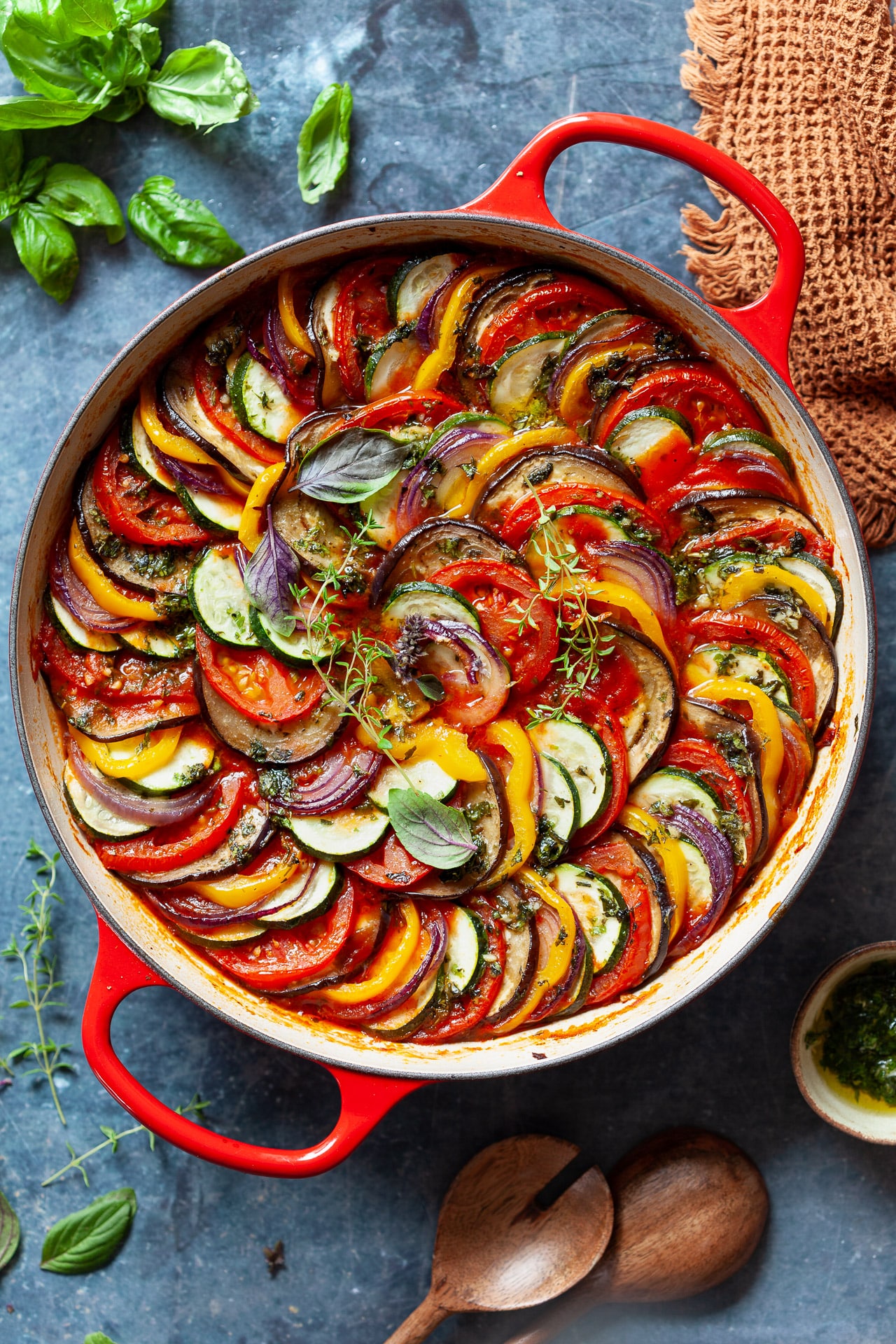Recipes: How to Make Classic French Ratatouille: A Beginner’s Guide
Embark on a culinary journey through Recipes: How to Make Classic French Ratatouille: A Beginner’s Guide and its flavors.
Related Recipes
- A Deep Dive Into Balado Terong: Indonesia’s Spicy, Savory Delight
- A Journey Through The Delicious World Of Boxty: From Humble Beginnings To Modern Culinary Delights
- Karaage: A Crunchy Journey Through Japanese Flavors
- A Journey Through The Layers Of Tiramisu: From Humble Beginnings To Culinary Masterpiece
- A Journey Through The World Of Empanadas: From Humble Beginnings To Culinary Masterpieces
Ingredients, Prep, Preparation Tips
Recipes: How to Make Classic French Ratatouille: A Beginner’s Guide

Ratatouille. The very word conjures images of sun-drenched Provençal fields, vibrant colors, and the intoxicating aroma of summer vegetables slow-cooked to perfection. This seemingly simple dish, a cornerstone of French cuisine, is more than just a vegetable stew; it’s a testament to the magic of letting fresh, high-quality ingredients shine. This comprehensive guide will walk you through every step of creating a classic French ratatouille, from selecting the perfect produce to achieving that melt-in-your-mouth texture that elevates it beyond the ordinary. Even complete beginners can master this iconic recipe with a little patience and attention to detail.
Understanding the Essence of Ratatouille
Before we dive into the specifics, let’s appreciate the philosophy behind ratatouille. It’s not about complicated techniques or exotic ingredients; it’s about respecting the inherent flavors of the vegetables. The goal is to coax out their natural sweetness and allow them to mingle harmoniously, creating a complex yet balanced flavor profile. This means using ripe, in-season produce and employing gentle cooking methods that preserve their texture and nutritional value.
Ingredients: The Heart of a Great Ratatouille
The beauty of ratatouille lies in its simplicity. The core ingredients are readily available, making it a fantastic dish for both experienced cooks and kitchen novices. However, the quality of your ingredients will significantly impact the final result.
Essential Ingredients:
- Eggplants (Aubergines): Choose firm, heavy eggplants with smooth, unblemished skin. Avoid those that feel spongy or have blemishes, as these indicate age. About 2 medium-sized eggplants are usually sufficient.
- Zucchini (Courgettes): Similar to eggplants, select firm zucchinis without soft spots. Aim for 2 medium-sized zucchinis.
- Bell Peppers: A mix of colors adds visual appeal and subtle flavor variations. Use 1 red bell pepper and 1 yellow bell pepper, or any combination you prefer.
- Onions: One large yellow onion provides a sweet base note. Shallots can also be substituted for a more delicate flavor.
- Garlic: Fresh garlic is crucial. Use about 4-6 cloves, depending on your preference for garlic’s pungent aroma.
- Tomatoes: The foundation of the sauce. Use about 2 pounds of ripe, flavorful tomatoes. You can use canned crushed tomatoes (look for high-quality brands with minimal added ingredients) if fresh tomatoes are unavailable, but fresh always provides a superior flavor.
- Olive Oil: Use a good quality extra virgin olive oil for its fruity aroma and rich flavor. About ½ cup should suffice.
- Herbs: Fresh herbs are essential. Use a generous amount of fresh basil, thyme, and oregano. About ¼ cup of each, chopped finely.
- Salt and Pepper: Season generously throughout the cooking process to enhance the flavors.
![[Detailed step image for TITLE]](https://www.vibrantplate.com/wp-content/uploads/2022/07/Homemade-Classic-French-Ratatouille-07.jpg)
Optional Ingredients:
- Mushrooms: Adding sliced mushrooms (cremini or button mushrooms work well) adds an earthy depth of flavor.
- Green Beans: A handful of trimmed green beans adds textural contrast.
- Rosemary: A sprig of fresh rosemary contributes a slightly piney aroma.
Preparation Advice: Laying the Groundwork for Success
![[Additional presentation of TITLE]](https://www.vegkit.com/app/uploads/2021/12/53264_classic_ratatouille_full.jpg)
Proper preparation is key to a successful ratatouille. Taking the time to meticulously chop the vegetables will not only enhance the visual appeal but also ensure even cooking.
1. Preparing the Eggplants:
Eggplants tend to absorb oil, so it’s essential to salt them before cooking. This draws out excess moisture, preventing them from becoming soggy. Slice the eggplants into ½-inch thick rounds, sprinkle generously with salt, and let them sit in a colander for at least 30 minutes (or up to an hour). This allows the salt to draw out excess moisture. After this, pat them dry thoroughly with paper towels.
2. Chopping the Vegetables:
Consistency in chopping is crucial for even cooking. Aim for roughly similar-sized pieces for all the vegetables. Dice the onions, bell peppers, and zucchini into roughly ½-inch cubes. Mince the garlic finely. If using mushrooms, slice them into similar-sized pieces.
3. Preparing the Tomatoes:
If using fresh tomatoes, roughly chop them. If using canned crushed tomatoes, simply open the can and set aside.
4. Mise en Place:
This French culinary term refers to having all your ingredients prepared and measured before you begin cooking. This organized approach ensures a smooth and efficient cooking process.
Cooking Instructions: The Art of Slow Cooking
Ratatouille is best made using a slow and gentle cooking method that allows the flavors to meld and the vegetables to soften without losing their integrity.
Step-by-Step Guide:
-
Sauté the Aromatics: Heat about ¼ cup of olive oil in a large, heavy-bottomed pot or Dutch oven over medium heat. Add the diced onions and sauté until softened and translucent, about 5-7 minutes. Add the minced garlic and sauté for another minute until fragrant, being careful not to burn the garlic.
-
Add the Eggplants and Peppers: Add the salted and dried eggplant slices and bell pepper cubes to the pot. Cook for about 5-7 minutes, stirring occasionally, until the eggplants begin to soften slightly.
-
Incorporate Zucchini and Other Vegetables: Add the zucchini, mushrooms (if using), and green beans (if using) to the pot. Stir gently to combine and cook for another 5 minutes.
-
Add Tomatoes and Herbs: Add the chopped tomatoes (or crushed tomatoes) to the pot. Stir in the fresh basil, thyme, and oregano. Season generously with salt and pepper.
-
Simmer to Perfection: Bring the mixture to a simmer, then reduce the heat to low, cover the pot, and let it simmer gently for at least 30 minutes, or up to an hour, stirring occasionally. The longer it simmers, the more the flavors will meld. The vegetables should be tender but still retain their shape.
-
Finish and Serve: Taste and adjust seasoning as needed. Stir in the remaining olive oil before serving.
Step-by-Step Visual Guide (Conceptual – Requires Images)
(This section would ideally contain a series of high-quality photographs or illustrations depicting each step of the cooking process. Since I cannot create images, I will describe what each image should show.)
- Image 1: Show the prepared ingredients: sliced eggplants sprinkled with salt, diced onions, bell peppers, zucchini, minced garlic, chopped tomatoes, and fresh herbs.
- Image 2: Show the onions and garlic sautéing in the olive oil.
- Image 3: Show the eggplants and bell peppers added to the pot and cooking.
- Image 4: Show all the vegetables simmering gently in the pot.
- Image 5: Show the finished ratatouille, ready to be served.
Professional Advice: Tips and Tricks from the Experts
- Don’t overcrowd the pot: Give the vegetables enough space to cook evenly. If necessary, cook them in batches.
- Use a heavy-bottomed pot: This helps distribute heat evenly and prevents burning.
- Taste and adjust seasoning throughout: The flavors will evolve as the ratatouille simmers.
- Don’t be afraid to experiment: Feel free to add other vegetables or herbs to customize the recipe to your liking.
- Let it rest: Allow the ratatouille to cool slightly before serving to allow the flavors to deepen.
Recipe Variations: Beyond the Classic
While the classic ratatouille is a masterpiece in its simplicity, there’s plenty of room for creative variations.
- Spicy Ratatouille: Add a pinch of red pepper flakes or a diced jalapeño for a spicy kick.
- Ratatouille with Sausage: Brown some Italian sausage before adding the vegetables for a heartier dish.
- Ratatouille with Potatoes: Add diced potatoes for added heartiness.
- Roasted Ratatouille: Roast the vegetables individually before combining them in the pot for a deeper, more intense flavor.
Nutrition & Serving Ideas: A Healthy and Versatile Dish
Ratatouille is a nutritionally dense dish packed with vitamins, minerals, and antioxidants. It’s a low-calorie, low-fat, and high-fiber option, making it a healthy addition to any diet.
Serving Suggestions:
- As a side dish: Serve it alongside grilled meats, fish, or poultry.
- As a main course: Serve it over rice, couscous, quinoa, or polenta.
- In a sandwich or wrap: Use it as a filling for sandwiches or wraps.
- As a pizza topping: Spread it over pizza dough before adding cheese and other toppings.
- In a frittata or quiche: Incorporate it into an egg-based dish for a hearty breakfast or brunch.
Serving Advice: Presenting Your Culinary Creation
The final presentation of your ratatouille is just as important as the cooking process itself. Serve it warm or at room temperature. Garnish with fresh basil leaves for an extra touch of elegance. Consider serving it in a rustic bowl or on a platter to enhance its visual appeal. A drizzle of extra virgin olive oil just before serving adds a beautiful sheen and enhances the flavor.
This comprehensive guide provides a solid foundation for creating a delicious and authentic French ratatouille. Remember, the key is to use fresh, high-quality ingredients, to take your time, and to enjoy the process. With a little practice, you’ll be crafting this Provençal classic with confidence and delighting your family and friends with your culinary skills.
Thank you for exploring Recipes: How to Make Classic French Ratatouille: A Beginner’s Guide with us! We hope this guide brought you new insights and inspiration for your cooking journey. Share your thoughts in the comments below or try out another recipe for further culinary exploration!





